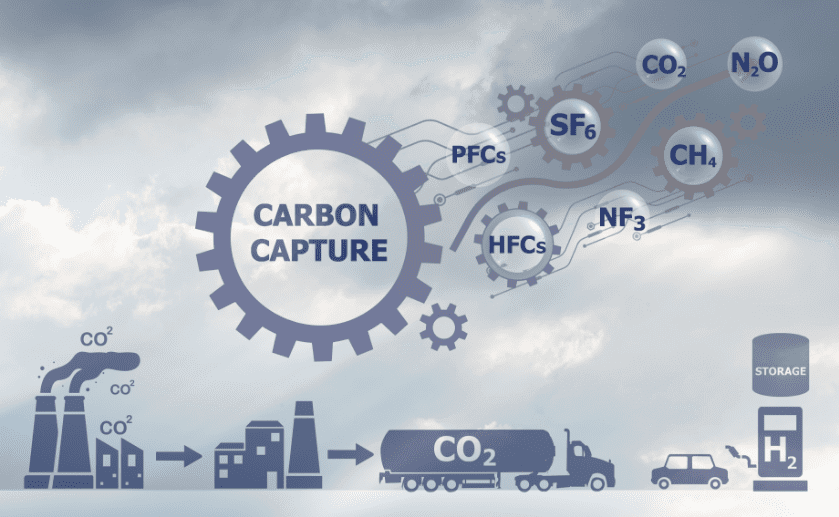Why CEOs of Hard-to-Abate Industries in India Should Consider Investing in CCUS?

As per the Paris Agreement, all nations worldwide are committed to reducing greenhouse gas (GHG) emissions by 45% by 2030 and reaching net zero by 2050. In this regard, reducing emissions from various industries is a great challenge. This is especially challenging for hard-to-abate industries like steel, cement, and chemicals. These industries are crucial for economic development. Yet, they account for about 30% of the world’s greenhouse gas emissions. The CCUS technology (carbon capture, utilization, and storage) is a possible solution. Let’s understand how CCUS is an ideal investment for Indian CEOs of hard-to-abate industries to tackle GHG emissions effectively.
What is CCUS?
CCUS represents a series of processes to capture CO2 directly from fossil, biomass stations, industries, or air and convert it for various applications. Once captured, the CO2 is transported by ship or pipeline to the point of storage or application. There, it gets processed for various applications. Majorly, it is used for enhanced oil recovery (EOR) or the production of low-carbon fuels like methanol. The same can be used as an input or feedstock to create products or services. Otherwise, the CO2 is securely stored in geological formations so that it does not enter the atmosphere and harm the climate balance. .php?post=24032&action=editCCUS represents a series of processes to capture CO2 directly from fossil, biomass stations, industries, or air and convert it for various applications. Once captured, the CO2 is transported by ship or pipeline to the point of storage or application. There, it gets processed for various applications. Majorly, it is used for enhanced oil recovery (EOR) or the production of low-carbon fuels like methanol. The same can be used as an input or feedstock to create products or services. Otherwise, the CO2 is securely stored in geological formations so that it does not enter the atmosphere and harm the climate balance.
What CCUS Technologies Are Available Today?
Some major CCUS technologies are available today to handle carbon emissions easily. Let’s understand how CO2 is processed under these CCUS technologies.
- Direct Air Capture (DAC): Collected directly from the using air filters
- Carbon Capture at Power Plants: CO2 is captured from power plants and processed for storage or enhanced oil recovery.
- Enhanced Rock Weathering (ERW): Crushed silicate minerals like basalt and glauconite increase the soil’s CO2 capture capacity.
- Aqueous Amine-Based CO2 Capture: Using amines to absorb CO2 for storage or reuse
- Membrane Gas Separation: Using permeable materials to separate carbon dioxide and other gasses at low temperatures and pressures
- Carbon Capture and Conversion: Converting the captured CO2 into usable products such as fuels, industrial chemicals, and polymers.
- Chemical looping: Using metal-based particles to separate CO2 from the fuel for storage and further reuse
- Cryogenic Carbon Capture (CCC): Leveraging cryogenic cooling to capture and remove CO2 from gas streams
- Carbon Capture Using Nanotechnology: Carbon nanotubes capture CO2 at a very low pressure
CCUS Global Application and Potential in India
CCUS has been gaining popularity for its effectiveness in handling carbon footprints from the environment. As per the IEA report, around 40 commercial facilities have benefited from applying CCUS to their industrial processes. It has been used as one of the primary ways of carbon capture and utility storage. Though CCUS deployment slowed down in the past, in recent years, it’s been under development for over 500 projects across the CCUS value chain.
How will Implementing CCUS Benefit Industries?
CEOs in India can leverage CCUS to:
- Meet Net-Zero Goals: India has committed to achieving net-zero emissions by 2070. In this regard, CEOs of hard-to-abate industries can use CCUS, which has already been a proven and effective method worldwide, to contribute significantly to achieving this ambitious green transition.
- Improve Energy Security: Companies can utilize the captured CO2 for EOR, like in the Ankleshwar oil field CO2-EOR project in Cambay Basin, India. This can enhance India’s energy security by extracting more oil from existing fields. As a result, it can reduce dependence on imported fuels and strengthen energy independence.
- Creating Economic Opportunities: The application of CCUS in Industries will unlock new job opportunities in India. Companies would require manpower to construct, operate, and maintain CCUS technologies, which will indeed create a positive economic impact.
- Have a Competitive Edge: As the global market increasingly focuses on low-carbon products, adopting CCUS allows Indian industries to remain competitive and adapt to changing market demands.
End Game: Accelerating Clean Energy Transition in India
For CEOs of hard-to-abate industries in India, CCUS is not just an option but a strategic necessity. CCUS application can promise industries long-term sustainability, contribute significantly to India’s green transition goals, and create a cleaner and brighter future for the nation. As the world moves towards a low-carbon future, adopting CCUS allows Indian industries to have a competitive edge in the market and attract new investors.
Are you looking forward to stepping up your industry’s strategy to reduce carbon emissions?
Visit our website to learn how Moglix Business custom fabrication solutions can accelerate your clean energy transition
